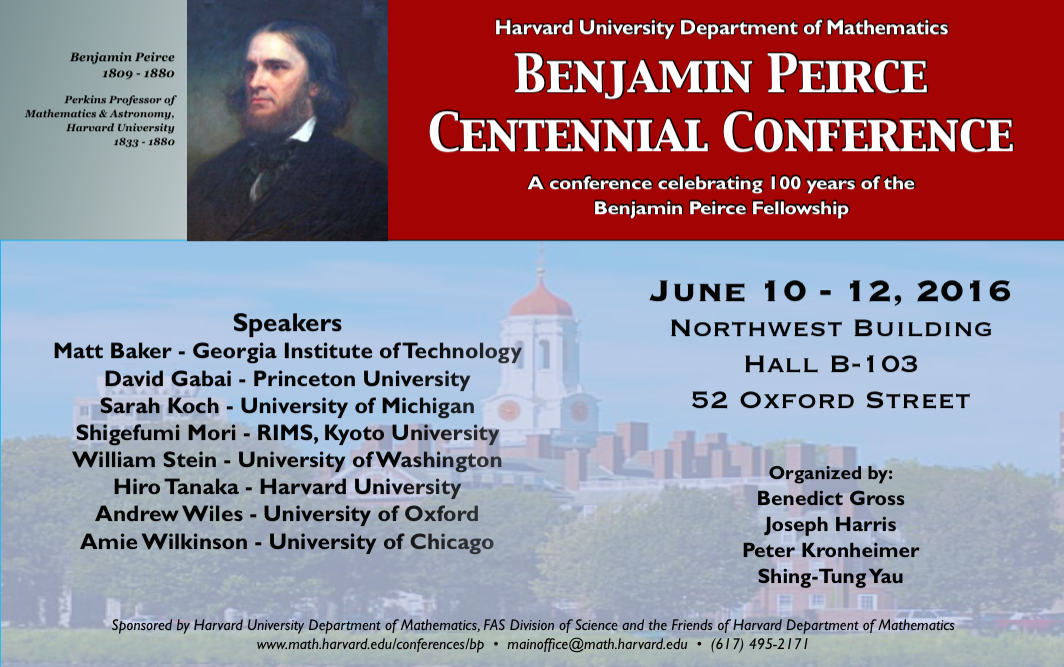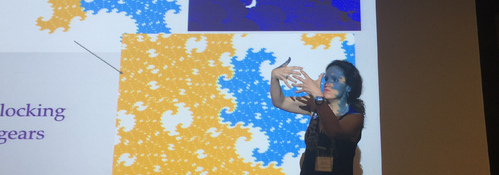Friday, June 10
2:30- 3:15 Refreshments
3:15- 3:30 Welcome
3:30- 4:30 Shigefumi Mori
4:30- 5:00 Break
5:00- 6:00 Amie Wilkinson
|
Saturday, June 11
9:00- 9:30 Refreshments
9:30-10:30 David Gabai
10:30-11:00 Break
11:00-12:00 Sarah Koch
12:00- 2:00 Lunch break
2:00- 3:00 Hiro Tanaka
3:00- 3:30 Break
3:30- 4:30 William Stein
|
Sunday, June 12
9:00- 9:30 Refreshments
9:30-10:30 Matt Baker
10:30-11:00 Break
11:00-12:00 Andrew Wiles
|

Abstracts: (alphabetic)
Matt Baker (Georgia Tech) The secret life of graphs
While a BP at Harvard, I first learned (from Joe Harris) about Castelnuovo's
brilliant insight that one could establish certain properties of a general
smooth curve by degenerating to singular curves. I also first heard (from Richard Taylor)
about Berkovich's amazing theory of non-Archimedean analytic spaces and (from Laura DeMarco)
about the use of potential theory in complex dynamics. All three of these ideas immediately
struck me as cool, but I did not realize that they were all related to one another, and
certainly had no idea that each would fundamentally change the direction of my mathematical
research. I will do my best to tell this story in a quasi-coherent way, with something I
learned in high school (Kirchhoff's laws for electrical networks) as a unifying theme.
David Gabai (Princeton University) Title: On slice missing slice discs
Nearly 60 years ago Barry Mazur proved that smooth 3-spheres in the 4-
sphere bound topological 4-balls to each side. (Actually, he proved
a much more general result.) Conjecturally such spheres bound smooth
4-balls. Using his remarkable argument we will outline a reduction of
this conjecture to one involving slice missing slice discs in certain
4-manifolds.
Sarah Koch (University of Michigan) Title: Dynamical data: roots of polynomials and
moduli spaces.
In his last paper, Entropy in Dimension One,
William Thurston completely characterized which algebraic integers
arise as exp(entropy(f)), where f is a postcritically finite real map
of a closed interval. (A map is called ``postcritically finite'' if
all of its critical points are eventually periodic under iteration).
On page 1 of this paper, there is a spectacular image of a subset of
the complex plane comprised of roots of polynomials which come from
entropy values associated to the dynamics of quadratic polynomials.
This set displays some amazing fractal structure which can be (somewhat)
understood when viewed as a distinguished subset of parameter space for
a particular dynamical system. In this talk, we will investigate the
structure of other distinguished subsets in moduli spaces arising from
dynamically-defined collections of polynomials. These projects (and some
others!) were directly inspired by reading Thurston's article in the
`reading group' I organized at Harvard as a BP.
Shigefumi Mori (Research Institute for Mathematical Sciences) Title: Rational Curves on Algebraic Varieties -
an encounter at Harvard and its later development
I would like to talk about an existence theorem for rational curves on an algebraic
variety, which was the key to my solution of Hartshorne's Conjecture
on projective space. It grew into a prototype theory of the cone of
curves and extremal rays covering smooth projective threefolds. These
were done when I was at Harvard. They were later developed further into
a more extensive and powerful theory as well as the so-called Minimal
Model Theory, which was finally settled in many practical cases in all
dimensions by the paper by C.Birkar, P.Cascini, C.Hacon, and J.McKernan
in 2010 and is now a fundamental tool in algebraic geometry. I have been
interested in and working on finer classifications in dimension three
cases, and will also discuss this in my talk.
William Stein: (University of Washington) The origins of Sage -- a viable open source alternative
to Magma, Maple, Mathematica, and Matlab
As a BP at Harvard in 2005, I created interactive web pages to let my
students use Magma to compute with elliptic curves and modular forms. I then
received the following email: "This is to formally advise you that your permission to
run a general-purpose calculator based on Magma expires on Dec 31." That
email changed my life. In my talk, I will describe why I founded Sage,
what has happened in the last decade, and where Sage is headed in
the future.
Hiro Tanaka (Harvard University): How Lagrangian cobordisms should recover Floer theory
"Floer theory" is about as important to symplectic geometry as "coherent
sheaves" are to algebraic geometry. (The most salient illustration of
this principle is Kontsevich's mirror symmetry conjecture.) And in the
last couple of decades, many symplectic geometers have come to suspect
that a particular class of symplectic manifolds should admit purely
topological characterizations of their Floer theory; in particular,
the usually complicated data coming from J-holomorphic PDEs should boil
down to basic topological ingredients. In this talk, we'll talk about
a road map to realizing this suspicion in a somewhat surprising way:
through the homotopy theory of Lagrangian cobordisms.
Andrew Wiles (Oxford University) Title: Modular curves and Elliptic curves
On arriving as a B.P. at Harvard I studied Barry Mazur's paper
'Modular curves and the Eisenstein Ideal' which was in press at the time.
I will talk about the influence of this paper both in our subsequent
collaboration and in my own work.
Amie Wilkinson (Chicago University) Title: "The general case"
The celebrated Ergodic Theorems of George Birkhoff and von Neumann in the
1930's gave rise to a mathematical formulation of Boltzmann's Ergodic
Hypothesis in thermodynamics. This reformulated hypothesis has been
described by a variety of authors as the conjecture that ergodicity --
a form of randomness of orbit distributions -- should be``the general
case" in conservative dynamics. I will discuss remarkable discoveries in
the intervening century that show why such a hypothesis must be false in
its most restrictive formulation but still survives in some contexts. In
the end, I will begin to tackle the question, "When is ergodicity and
other chaotic behavior the general case?"
| Last update: March 26, 2016, Department of Mathematics, Harvard University
|
|


